Text
#Liverpool John Moores University#LJMU#IM Marsh Campus#higher education#undergraduate studies#postgraduate studies#professional courses#technical courses#Dance Studies#Sport Development#Physical Education#Applied Community Studies#Social Studies#Community Nutrition#Consumer Studies#Marketing#Food and Nutrition#Home Economics#Tourism Management#Education Studies#Outdoor Education#Adventure Tourism#OFSTED inspections#TTA category A status#PE secondary initial teacher education#Liverpool#LJMU popularity#quality teaching#personal tutoring#academic facilities
0 notes
Text
#pathway programmes#international students#study in uk#study in united kingdom#ljmu#liverpool john moores university#higher education
0 notes
Text
Some Black History In Classic Doctor Who
Something I've been itching to make a post about as I made my way through classic who! I hope you enjoy ^o^


In the 4th season of Doctor Who (1966), the missing serial "The Smugglers" featured the first black character with a speaking role. This character was named Jamaica and he was played by Elroy Josephs! He was tasked with guarding the captured 1st Doctor, and was later killed for failing to keep guard over him.
Elroy Josephs was born in Jamaica, and besides being an actor he was also a dancer. He became the first black dance lecturer at IM Marsh in Liverpool, which is part of Liverpool John Moores University.
Elroy Josephs is often overlooked for his influence on black British dance and on November 1997, a bench and plaque was unveiled in Elroy's memory at John Moores University.
More about his influence of black dance in Britain can be read here
★


The serial immediately after was called "The Tenth Planet" and this serial featured Earl Cameron as Glyn Williams, the first black astronaut in television (I've seen people say it's actually Nichelle Nichols in Star Trek, since she appeared on Star Trek JUST a month earlier in 1966, though I'd argue the portrayal in Doctor Who is more akin to what we know an astronaut to be. Still, a crazy close call!)
Glyn Williams, alongside another astronaut, discovers the Cyberman home planet Mondas in their rocket. This is the first serial to feature the cybermen, too! Their rocket gets pulled in by Mondas's gravitational pull and they die in an explosion.
Earl Cameron was born in Bermuda, and is well known as the first black actor to take a leading role in a British film! The movie was called "Pool of London" and was released in 1951. It was his performance in this movie that led to him becoming "Britain’s first home-grown, non-American black movie star"!
Earl Cameron passed away in 2020 at the age of 102, making him the 5th Doctor Who cast member to reach his 100th birthday!
★ - ★ - ★


"The Tomb Of The Cybermen (season 5)" and "Terror Of The Autons (season 8)" featured 2 characters, both played by Roy Stewart. Both characters have been criticised for their racist depiction of a black man. In TTOTC, Roy played the character of Toberman, who was a mute servant of an expeditioner and the strongest one of the team. He had no say in any matters and was supposed to be purely muscle. He was partially cyberconverted and sacrificed himself to save everyone.
In TOTA, Roy played the character Tony, a strongman with animal furs also tasked to be brute force. He helped keep the 3rd doctor captive, but was knocked out by Jo Grant.
Born in Jamaica, Roy Stewart came to the UK with the idea to become a doctor, though he ended up changing his mind to start acting. There weren't many black stuntmen out there (they would have white people "black up"). He ended up doing a lot of stunt work and became one of Britain's top black actors/stuntmen! Though, a lot of his earlier work went uncredited.
Roy Stewart also ran a gymnasium in 1954 with a policy allowing people of all races to train together. He also opened a Caribbean restaurant and bar called The Globe in 1960, which he ran until the day he died (2008). The Globe is now one of longest-running nightclubs in London, still with a Caribbean restaurant upstairs.
"Frequented by Jimi Hendrix, The Rolling Stones, Van Morrison, The Clash and Bob Marley, The Globe became the place to be. Its notoriety was such, that even Mick Jones of The Clash named his album after it and wrote the title song about the nightclub." - The Globe Website
★ - ★ - ★


In season 5 the serial "The Enemy Of The World", Carmen Munroe played the role of Fariah Neguib, a food taster for the powerful politician, Ramón Salamander. She was a food taster by force, and rebelled against Salamander by giving the 2nd Doctor's allies important documents, revealing a black mailing side to the politician. She was shot and died in the arms of the enemy, pridefully refusing to give them information. Though sources are a bit muddy on this (1 sketchy source and the rest is my memory of classic who), Carmen Munroe could very well be the first black woman in Doctor Who. And if not, She is most certainly the first with a prominent speaking role.
Born in Guyana, Carmen Munroe played an instrumental role in the development of black British theatre and representation on tv. She played a good number of leading roles, but is best known for the role of Shirley in British TV sitcom Desmond's. Carmen is also one of the founders of Talawa, the UK's leading black theatre company, which was created in response to the lack of creative opportunities for Black actors and the marginalisation of Black peoples from cultural processes.
Today, Talawa is the primary Black theatre company in the UK, with more than 50 award-winning touring productions from African classics to Oscar Wilde behind it. In total the company has produced more than 80 productions. Our name, Talawa, comes from a Jamaican patois term and means gutsy and strong - Talawa.com
Carmen was also appointed Officer of the Order of the British Empire (OBE), which is a British order of chivalry, rewarding contributions to the arts and sciences, work with charitable and welfare organizations, and public service outside the civil service.
★ - ★ - ★
Hope you enjoyed reading this bit of Doctor Who/Black History! Please feel free to add to this post with more black history in Doctor Who!
#I ran a bit out of steam though there's definitely more out there!#doctor who#black history#doctor who black history#classic#classic who#classic doctor who#doctor who classic#second doctor#2nd doctor#the second doctor#talkies#1st doctor#first doctor#the first doctor#carmen munroe#fariah neguib#roy stewart#toberman#doctor who toby#doctor who toberman#earl cameron#glyn williams#elroy josephs#doctor who jamaica#black artist#black actors#history#doctor who history#television history
887 notes
·
View notes
Text
Apply Now: Liverpool John Moores University Postgraduate Scholarships For International Students 2023
Apply Now: Liverpool John Moores University Postgraduate Scholarships For International Students 2023
Liverpool John Moores University LJMU offer scholarships to postgraduate students wishing to study with us from overseas. These scholarships are in the form of tuition fee reductions and working alongside other external funding councils to produce many options for our students. LJMU will award an exceptional student experience renowned for its high-quality teaching, innovation, student…

View On WordPress
#Apply Now: Liverpool John Moores University Postgraduate Scholarships for International Students 2023#Liverpool John Moores University Accreditation#Liverpool John Moores University admission#Liverpool John Moores University CAS#Liverpool John Moores University courses for International students#Liverpool John Moores University entry requirements#Liverpool John Moores University fees#Liverpool John Moores University isc#Liverpool John Moores University postgraduate open Day#Liverpool John Moores University ranking#Liverpool John Moores University scholarships for international students#LJMU scholarship application form#LJMU scholarship postgraduate#University of Liverpool scholarships for international students
0 notes
Text
“It was an assumption—almost an article of faith—amongst many biogeographers, ecologists, and paleoecologists that the great regional rainforests were, at Western contact, the product of natural climatic, biogeographic, and ecological processes,” wrote paleoecologist Chris Hunt, now based at Liverpool John Moores University, and his colleague, Cambridge University archaeologist Ryan Rabett, in a 2014 paper. “It was widely thought that peoples living in the rainforest caused little change to vegetation.” New research is challenging this long-held assumption. Recent paleoecological studies by Hunt and other colleagues show evidence of “disturbance” in the vegetation around Pa Lungan and other Kelabit villages, indicating that humans have shaped and altered these jungles not just for generations—but for millennia. Borneo’s inhabitants from a much more distant past likely burned the forests and cleared lands to cultivate edible plants. They created a complex system in which farming and foraging were intertwined with spiritual beliefs and land use in ways that scientists are just beginning to understand. Samantha Jones, lead author on this investigation and researcher at the Catalan Institute of Human Paleoecology and Social Evolution, has studied ancient pollen cores in the Kelabit Highlands as part of the Cultured Rainforest Project. This is a U.K.-based team of anthropologists, archaeologists, and paleoecologists that is examining the long-term and present-day interactions between people and rainforests. The project has led to continuing research that is forming a new scientific narrative of the Borneo highlands. People were most likely manipulating plants from as early as 50,000 years ago in the lowlands, Jones says. That’s around the time humans likely first arrived. Scholars had long classified these early inhabitants as foragers—but then came the studies at Niah Cave. There, in a series of limestone caverns near the coast, scientists found paleoecological evidence that early humans got right to work burning the forest, managing vegetation, and eating a complex diet based on hunting, foraging, fishing, and processing plants from the jungle. This late Pleistocene diet spanned everything from large mammals to small mollusks, to a wide array of tuberous taros and yams. By 10,000 years ago, the folks in the lowlands were growing sago and manipulating other vegetation such as wild rice, Hunt says. The lines between foraging and farming undoubtedly blurred. The Niah Cave folks were growing and picking, hunting and gathering, fishing and gardening across the entire landscape.
[...]
“The Cultured Rainforest project has shown how profoundly entangled the lives of humans and other species in the rainforest are,” says University of London anthropologist Monica Janowski, a member of the project team who has spent decades studying highland Borneo cultures. “This entanglement has developed over centuries and millennia and succeeds in maintaining a relatively balanced relationship between species.” Borneo’s jungle is, in fact, anything but untouched: What we see is a result of both human hands and natural forces, working in tandem. The Kelabit are a little bit farmer and a little bit forager with no clear line between, Janowski says. This dualistic approach to land use may reveal a deeper human nature. “Scratch any modern human and you will find, under the surface, a forager,” she says. “We have powerful foraging instincts. We also have powerful instincts to manage plants and animals. Both of these instincts have been with us for millennia.”
259 notes
·
View notes
Text

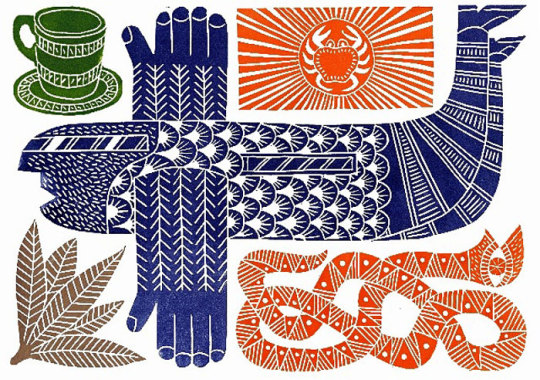
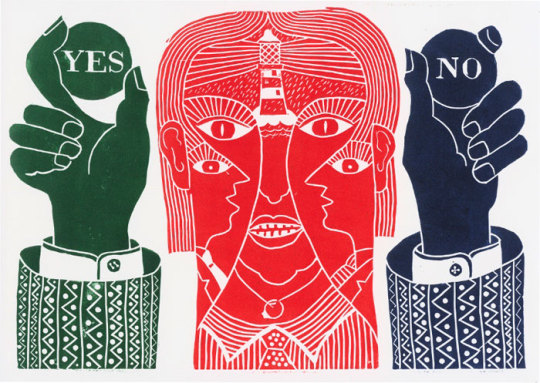
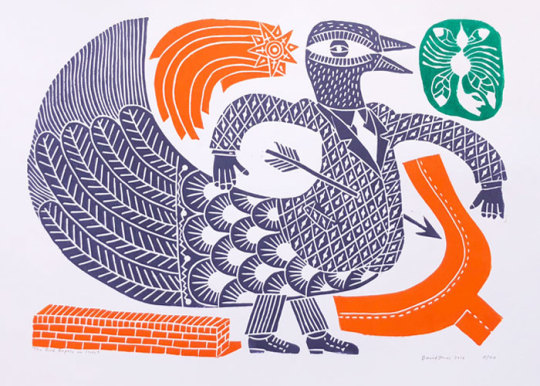
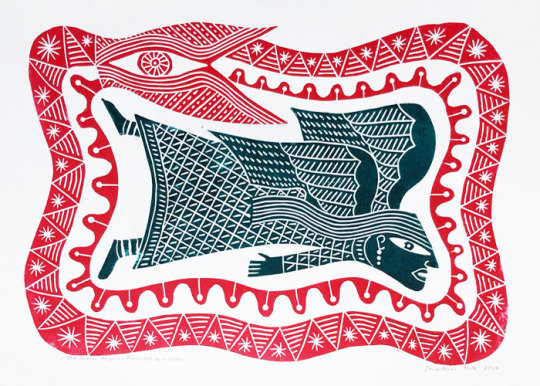
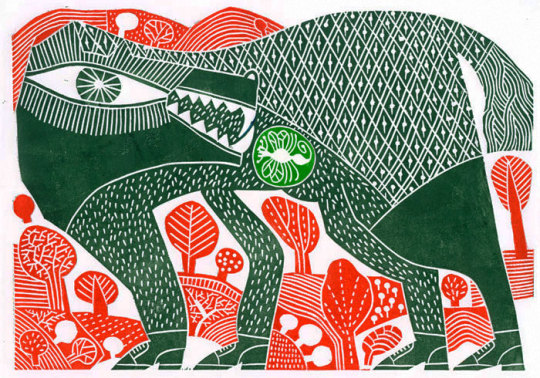
One of my favourite British artists - David Jones (b 1939) graduated from Liverpool College of Art in 1961 and it was here he first discovered his interest in printmaking. His tutor was the surrealist artist George Jardine. He won a John Moores travelling scholarship and spent time visiting various design studios across Europe. On returning to the UK he worked as assistant to graphic designers Jock Kinneir and Margaret Calvert. In 1965 -1967 he worked in Japan at Nakamoto International Agency, Osaka.
He returned to the UK and had a busy and successful career working freelance in graphic design, illustration and typography. He also worked as a visiting college lecturer at many of the countries leadings art schools. From 1979 he was a Senior Lecturer at Central Saint Martins (University of The Arts, London). In the last twenty years he has returned to printmaking, in particular linocuts and wood engraving. He is influenced by Outsider art and Folk art. In 1989 he helped set up Raw Vision, a journal of Outsider Art. David is also a keen Semi-pro musician and plays the soprano saxophone. He hand prints his work in small editions and many of the images in his prints come from dreams.
65 notes
·
View notes
Text

45 years ago today- Oct. 13 1978 - the physics and scientific community was shocked when budding astrophysicist Brian May and his colleagues discovered what actually makes the world go-round. Their work, entitled "Fat-Bottom Girls", was released on this date back in 1978.
Unfortunately, May, pictured below with friend and collaborator Eddie Van Halen, would not be awarded the Nobel Prize in Physics, despite his groundbreaking (pun intended) research into females with well-endowed posteriors. May would later earn his Ph.D in Astrophsyics from Imperial College London and would later serve as Chancellor of Liverpool John Moores University from 2008 to 2013.
58 notes
·
View notes
Text
𝕖𝕝𝕖𝕟𝕒

Full Name: Elena Isabela Maria Serrano
Nicknames: El, Ellie, Lena
Date Of Birth: 14th February 2002
Star signs: Capricorn
Place of Birth: Barcelona, Spain
Current Residence: Islington, London, England
Languages: English, Italian and Spanish.
Height: 166 cm (5 Foot 5 Inches)
Instagram: el.serrano
Occupation: Paramedic
Face Claim: Tyla (Singer and Model)
FACTS ABOUT ELENA:
* She came out, well was forced out of the closet at 16.
* She then moved in with her best friend in Barcelona for a few months, before moving to England in 2019, to escape Spain, as everywhere was reminding her of the problems with her family.
* When she came out her family found it disgusting that she is a lesbian. And disowned her, and kicked her out of the family home.
* She cut all contact with them and hasn't seen them since she left when she was 16.
* She went to Liverpool John Moores, studying Paramedic Sciences.
* And in her third year was attacked on a job, involving a regular patient, who was know to be abusive and violent towards the Paramedics. And he went to strangle her with a wire, when she went into his house alone, before her paramedic mentor did as they were bringing the rest of the stuff they needed.
* Luckily her mentor came in not long after Elena did but the damage had been done as Elena has passed out, and the man had cut her neck, luckily not cutting her jugular but she now has scars over her neck from it.
* She loves a good gossip session, she thrives on it to be honest.
* Very protective over her own trust, she doesn't forgive people quickly or easily at all.
* She dated Eva from 2021 to 2022 for about a year and a half.
* Elena is exceptionally clingy, or she loves like someone holding her hand, or just being touchy with someone, and that person has to know and like that she will be touchy with them.
* Elena is a perfectionist, she would rather something be done once and it takes a long time but be perfect then rush something.
* She thinks that if you're going into a relationship for something short term then you are just foolish.
* Has Chronic Resting Bitch Face, however in reality she is so fun and light hearted.
* Is much more on the femme side of being a lesbian.
* Is the biggest ambivert that one could be. If you don't know her she is so quiet, or can seem quiet, but if you make her comfortable, she is so extroverted, and she is wild!
* She is best friends with Jana Fernandez and therefore Bruna Vilamala. She lived with Jana and Jana's family after she was kicked out before moving to England.
* Whenever the Barcelona team come to the UK, or Jana does, they always make it so Jana can stay and see Elena.
Body Modifications: Piercings

* Elena has four piercings, her belly button, and her first through thirds in her ears.
* She got her first through thirds when she was 18 and 19, when she was in college, and on a break from uni over the summer.
* Elena then got her belly button done when she was 20, on her summer holiday from university, and she loved changing the piercing in it.
Body Modifications: Tattoos

* Elena's first tattoo was the little heart on her chest, above her own heart on the left side. * Elena's next tattoo was 'We'll be alright' on the back side of her right arm. * Then Elena got the sun on the front of her right shoulder. * Elena then got then two butterflies to match with Jana as she got it on the inside of her right wrist, with Jana getting it on her ankle. * Elena got the body and vines on the front of her upper right arm, just above her elbow ditch. * The rose outline was the next tattoo that Elena got on her right forearm. * Elena got the frog and duck on her right forearm. * Then Elena got the book reading frog on her right forearm on the other side of her arm. * Born to die was the next tattoo Elena got and it was on the inside of her left wrist. * The latest tattoo before I Kissed A Girl was the angel wings and halo on the back of her neck.
Episode 1 >>>
5 notes
·
View notes
Text

[ID:
Map of Britain titled "37 TOTAL BRITISH UNI ENCAMPMENTS" and subtitled "WHERE ARE THEY NOW?". The graphic is marked "LONDON STUDENT ACTION FOR PALESTINE" with the LSAP logo in the bottom-left. An asterisked small print reads "*LOCATION PINS ARE NOT 100% ACCURATE. AS OF 12/8/24"
On the map, the location of each university where there was a pro-Palestine encampment is represented by a small tent symbol. The names of the universities are written on the map, with colour-coded backgrounds. The colours of the backgrounds of the uni names represent what happened with the encampment. By category, the universities are:
Ongoing: 2x
Bangor University
University of Cambridge
Ongoing after Eviction: 1x
SOAS
Decamped with Ongoing Negotiations: 15x
University of Aberdeen
Aston University
Cardiff University
University of Edinburgh
GS
ICL
University of Kent
University of Leicester
University of Manchester
Newcastle University
University of Portsmouth
University of Sussex
University of Swansea
University of Warwick
University of York
Decamped: 7x
Aberystwyth Uni
Durham University
University of Exeter
Falmouth University
University of Leeds
University of Lincoln
UAL
Decamped with Legal Threat + Police: 5x
University of Bristol
Lancaster University
University of Liverpool + Liverpool John Moores
University of Nottingham
University of Oxford
Evicted: 7x
University of Birmingham
KCL
LSE
QM
University of Reading
University of Sheffield
UCL
/End ID]
2 notes
·
View notes
Text
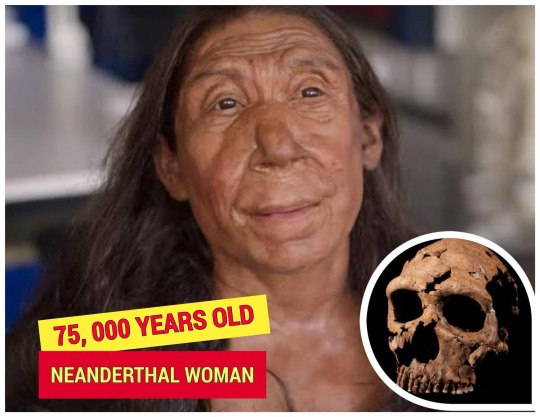
"The skull was as flat as a pizza, basically," said Professor Graeme Barker
An absolute astonishing discovery and work by a team of British archaeologists who managed to reconstruct a 75,000 years of Neanderthal woman skull
Dubbed Shanidar Z, discovered in the Shanidar cave in the Kurdistan Region.
The groundbreaking discovery offers fresh insights into the lives of Neanderthals and challenges previous perceptions of their intelligence and behaviors.
Shanidar Z, named after the cave where her skull was unearthed in 2018, represents a significant find in the study of Neanderthals. Led by researchers from the University of Cambridge and Liverpool John Moores University, the excavation sheds light on ancient burial rituals and Neanderthal culture.
The discovery rekindles interest in the work of American archaeologist Ralph Solecki, who first unearthed Neanderthal remains in the same cave in the 1960s. Solecki's findings, which included the remains of multiple Neanderthals and evidence of burial practices, suggested a level of sophistication previously unrecognized in these ancient hominids.
Despite political challenges delaying further exploration for decades, the recent excavation allowed researchers to delve deeper into Shanidar Z's story. Her remarkably preserved skull, flattened to a thickness of 0.7 inches, offers unprecedented insights into Neanderthal anatomy and behavior.
Dr. Emma Pomeroy, a palaeo-anthropologist from the University of Cambridge, described the discovery as a privilege and emphasized its potential to deepen our understanding of Neanderthal life. "It's extremely exciting and a massive privilege actually to be able to work with the remains of any individual but especially one as special as her," she told BBC News.
The team's return to the Zagros mountains in the Kurdistan Region underscores the significance of ongoing research in unlocking the mysteries of human evolution. "The skull was as flat as a pizza, basically," said Professor Graeme Barker from Cambridge's McDonald Institute for Archaeological Research, highlighting the remarkable preservation of Shanidar Z's remains.
Neanderthals, who disappeared from the Earth around 40,000 years ago, continue to fascinate scientists and the public alike. Each new discovery, such as Shanidar Z's reconstructed face, adds layers to our understanding of these ancient relatives and their place in the human story.
As archaeologists continue to analyze Shanidar Z's remains and unearth new discoveries, their findings promise to reshape our understanding of Neanderthal life and their interactions with early humans.
Source: https://www.basnews.com/en/babat/847393
Image: 3D images of Shanidar Z can be seen in the BBC documentary «Neanderthal Secrets» broadcast on Netflix
Source: Facebook
The Tudor Intruders
3 notes
·
View notes
Text
Will there be an end to Israel's killing of civilians in Gaza?
youtube
A 'horrific massacre' - that's how Palestinians are describing one of the worst Israeli attacks on Gaza, since the war began. More than 90 Palestinians were killed and 300 injured on Saturday, in al-Mawasi - an area Israel had designated as safe. Its fighter jets and drones unleashed a barrage of missiles and bombs, obliterating tents that sheltered thousands of displaced families. As the death toll rises and the humanitarian crisis deepens, there are serious questions about Israel's military conduct and the protection of civilians. Israel claims it was targeting Hamas leaders. But is that justification for killing so many civilians?
Presenter:
Mohammed Jamjoom
Guests:
Ibrahim Yaghi - Writer, poet and activist.
Tahani Mustafa - Senior Palestine Analyst at the International Crisis Group.
Triestino Mariniello - Professor of Law at Liverpool John Moores University, and a member of the Legal Team representing Gaza Victims before the ICC.
2 notes
·
View notes
Text
According to a Live Science report, a new study has suggested that the pollen once thought to have belonged to flowers deposited by Neanderthals in Iraqi Kurdistan's Shanidar Cave was actually left there by insects. Paleoecologist Chris Hunt of Liverpool John Moores University said that previous interpretations that the pollen came from flowers that were collected by Neanderthals to be buried with a deceased member of their community was more likely deposited by bees. Hunt explains that the bees might have burrowed into the dirt on the cave floor, leaving pollen they had collected there as they dug in.
Since the 1950s and 1960s when the caves of Shanidar were first excavated, the flowers have been thought to be evidence of Neanderthals engaging in deliberate burial rituals.
Hunt believes that while the pollen may not have been part of a burial ritual, that does not negate the possibility that the Neanderthals living in the area engaged in this type of symbolic behavior.
10 notes
·
View notes
Text
Whether it is a hug from a friend or the caress of a weighted blanket, the sensation of touch appears to bring benefits for the body and mind, researchers say.
The sense of touch is the first to develop in babies and is crucial in allowing us to experience the environment around us as well as communicate. Indeed, the loss of touch from others during the Covid pandemic hit many hard.
However, while myriad studies have suggested touch is beneficial for our health, few have attempted to draw the vast field of research together.
Now experts have done just that, revealing a simple message: touch helps.
Dr Helena Hartmann, a co-author of the research from University Hospital Essen, said: “More consensual touch events throughout our day can help alleviate or potentially buffer against mental and physical complaints.”
Published in the journal Nature Human Behaviour, the research encompassed 212 previously published studies and included a statistical analysis of 85 studies involving adults and 52 involving newborns.
Among the results, the team found touch was just as beneficial for mental health as physical health – a finding that held for adults and newborns – although touch had a bigger impact on some areas than others.
“Our work illustrates that touch interventions are best suited for reducing pain, depression and anxiety in adults and children as well as for increasing weight gain in newborns,” the researchers write.
The analysis revealed humans gained similar benefits in terms of their physical health when touched by other humans as by objects – such as social robots or weighted blankets.
Hartmann said that was a surprise. “This means we need to undertake more research on the potential of weighted blankets or social robots to improve people’s wellbeing, especially during contact-limiting situations like the recent Covid-19 pandemic,” she said.
The positive impact on mental health was larger for human touch than touch from objects – possibly, the team said, because it involved skin-to-skin contact.
Among other results, the team found touch was beneficial for both healthy and unwell people, although the impact was larger among the latter for mental health benefits.
The type of touch and its duration was not important, although greater frequency was associated with greater benefits in adults.
Further, touching the head was associated with greater health benefits than touching other parts of the body.
The team cautioned that some of the findings could be false positives, while it was not clear if they would hold across different cultures.
Dr Mariana von Mohr, from Royal Holloway, University of London, who was not involved in the work, said if future robots could more accurately replicate the texture and warmth of human skin, they may be able to provide comparable mental health benefits to human touch.
“[These properties are] important because our skin contains specialised sensors, known as C-tactile afferents, which are particularly receptive to gentle, caressing touch and temperature similar to that of human skin, factors that are also thought to facilitate emotional regulation,” she said.
Prof Katerina Fotopoulou, at University College London, said the research gave a bird’s-eye view of the benefits of touch interventions on health.
She cautioned that the work could not offer more specific conclusions, such as the particular types of touch that may be associated with specific health benefits.
Dr Susannah Walker, at Liverpool John Moores University, agreed, noting that many of the studies considered were small and included varied types of touch and different measures of their outcomes. “This means it is hard to draw firm conclusions about why they work,” she said.
Fotopoulou added that the research could fuel new work in the field, including how touch could be used alongside other treatments.
“It is a historical misfortune that we have prioritised talking over touch or other somatic therapies in the past couple of centuries. This review gives us the necessary emphasis and confidence to redress this balance with further, careful study on touch interventions,” she said.
3 notes
·
View notes
Text
Gone is the stereotype of Neanderthals tearing into raw tubers or gnawing on a leg of roasted animal meat. Microscopic analysis of ancient food scraps unearthed from a hearth in Shanidar Cave, in Iraq, has provided the first real indication of complex cooking – and thus of food culture – among Neanderthals.
According to Dr Ceren Kabukcu, of the University of Liverpool, who carried out the analysis, a typical dish would probably have contained a pounded pulp of pulses, nuts and grass seeds, bound together with water and flavoured with bitter tannins from the seed coats of pulses such as beans or peas, and the sharp taste of wild mustard.
Gathering such ingredients must have been time-consuming. “There are lots of species out at Shanidar in the savannah-type vegetation, and I’d guess the Neanderthals would have gathered whatever they came across and cooked with it,” said Prof Chris Hunt, of Liverpool John Moores University, who coordinated the excavation.
While lacking easy access to a savannah, I do have the convenience of several health food shops and a Turkish mini-mart within minutes of my house. Sadly, these didn’t stock terebinth (wild pistachio) or bitter vetch (a legume), but commercial raw pistachios and puy lentils provided acceptable substitutes.
Tucked away at the back of our larder, I found a half-empty packet of fava beans with a use-by data of 2010 – not quite neolithic, but ancient enough.
Kabukcu and Hunt suggested combining these – or other types of dried beans or peas (not marrowfat) – with an ancient whole grain such as spelt, einkorn wheat berries or barley, in default of grass seed. Neanderthals also used wild almonds and mustard seeds in their cooking.
Interesting to see that they were able to identify bitter vetch among the pulses consumed by Neanderthals. I know the plant (I think specifically the root?) was used in medieval Scotland as an appetite suppressant during lean times. I wonder if our hominid cousins ever used it this way too.
33 notes
·
View notes
Text
Prehistoric cooking may have been more complex than we thought, according to a study published last week in the journal Antiquity.
Researchers analyzed charred food remains at two locations—the Shanidar Cave in Iraq’s Zagros Mountains and the Franchthi Cave in Greece—to gain insight into how Neanderthals and early modern humans prepared food. They found evidence of cooking involving a variety of ingredients, processes and deliberate decisions.
“Our findings are the first real indication of complex cooking—and thus of food culture—among Neanderthals,” Chris Hunt, an expert in cultural paleoecology at Liverpool John Moores University and coordinator of the excavation, tells the Guardian’s Linda Geddes.
At the Shanidar Cave, the researchers analyzed food remains from approximately 70,000 years ago, when Neanderthals lived at the site. They also analyzed remains from around 40,000 years ago, when early modern humans lived there. At the Franchthi Cave, they analyzed food remnants that early modern humans who were hunter-gatherers consumed some 12,000 years ago.
At both archaeological sites, researchers identified similar plants and culinary practices, which may point to a shared food culture, says lead study author Ceren Kabukcu, an archaeobotanical scientist at the University of Liverpool, to CNN’s Katie Hunt.
The researchers’ analysis suggests that early modern humans and Neanderthals weren’t just consuming protein from animals; they had complex diets that consisted of a wide selection of plants and varied depending on location. They also used “a range of tricks to make their food more palatable” such as soaking and pounding, per a statement from the University of Liverpool.
“This study points to cognitive complexity and the development of culinary cultures in which flavors were significant from a very early date,” says Kabukcu in the statement. “Our work conclusively demonstrates the complexities in the early hunter-gatherer diet which are akin to modern food preparation practices. For example, wild nuts and grasses were often combined with pulses, like lentils, and wild mustard.”
John McNabb, an archaeologist at the Centre for the Archaeology of Human Origins at the University of Southampton who was not involved in the research, tells CNN that our knowledge of the Neanderthal diet has greatly evolved “as we move away from the idea of [Neanderthals] just consuming huge quantities of hunted game meat.”
“More data is needed from Shanidar, but if these results are supported then Neanderthals were eating pulses and some species from the grass family that required careful preparation before consumption,” he adds. “Sophisticated techniques of food preparation had a much deeper history than previously thought.”
To further understand the Neanderthal diet, Hunt and his colleagues tried to recreate—and eat—a similar recipe using seeds found near the caves.
How did their creation turn out? Hunt tells the Guardian, “It made a sort of pancake-cum-flatbread which was really very palatable—a sort of nutty taste.”
8 notes
·
View notes
Text
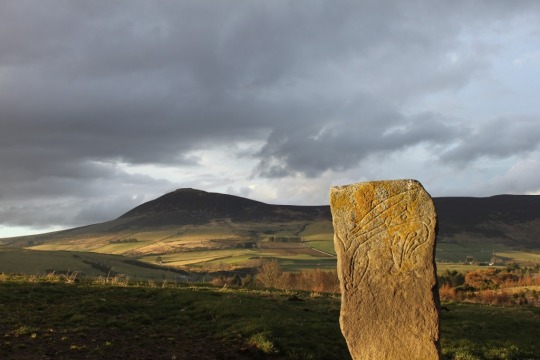
Study reveals new insights into the origins of Scotland's mysterious Picts
Scotland's Picts have long been viewed as a mysterious people with their enigmatic symbols and inscriptions, accentuated by representations of them as wild barbarians with exotic origins.
But a newly published study by an international team led by researchers at the University of Aberdeen and Liverpool John Moores University is helping to shed new light on the origins of the Picts.
The Picts were first mentioned in the late 3rd century CE as resisting the Romans and went on to form a powerful kingdom that ruled over a large part of northern Britain, in present-day north-east Scotland.
In the medieval period, the Picts were considered immigrants from Thrace (north of the Aegean Sea), Scythia (eastern Europe), or isles north of Britain but as they left few written sources of their own little is known of their origins or relations with other cultural groups living in Britain.
Archaeologists have conducted the first extensive analysis of Pictish genomes and their results have been published today (27/04/2023) in the open access journal PLOS Genetics.
The results reveal a long-standing genetic continuity in some regions of the British Isles, helping to build a picture of where the Picts came from and providing new understanding of how present-day genetic diversity formed. The findings also confirm descriptions by the great English historian Bede of the far-flung eastern origins of the Picts as one of myth and fantasy.
The researchers used Identity-By-Descent (IBD) methods to compare two high-quality Pictish genomes sequenced from individuals excavated from Pictish-era cemeteries at Lundin Links in Fife (Southern Pictland) and Balintore in Easter Ross (Northern Pictland) to those of previously published ancient genomes as well as the modern population.
Dr Linus Girdland Flink of the University of Aberdeen, senior corresponding author of the study, said: “Among the peoples present during the first millennium CE in Britain, the Picts are one of the most enigmatic.
“Their unique cultural features such as Pictish symbols and the scarcity of contemporary literary and archaeological sources resulted in many diverse hypotheses about their origin, lifestyle and culture, part of the so-called ‘Pictish problem’.
“We aimed to determine the genetic relationships between the Picts and neighbouring modern-day and ancient populations.
“Using DNA analysis, we have been able to fill a gap in an understudied area of Scotland’s past.
“Our results show that individuals from western Scotland, Wales, Northern Ireland, and Northumbria display a higher degree of Identity-By-Descent (IBD) sharing with the Pictish genomes, meaning they are genetically most similar among modern populations.”
This genetic make-up was distinct from areas of southern England where there is a greater relative degree of Anglo-Saxon heritage.
Dr Adeline Morez from Liverpool John Moores University, lead corresponding author of the study, adds: “Our findings also support the idea of regional continuity between the Late Iron Age and early medieval periods and indicates that the Picts were local to the British Isles in their origin, as their gene pool is drawn from the older Iron Age, and not from large-scale migration, from exotic locations far to the east.
“However, by comparing the samples between southern and northern Pictland we can also see that they were not one homogenous group and that there are some distinct differences, which point to patterns of migration and life-time mobility that require further study.”
The analysis of mitochondrial genomes from Lundin Links has also provided an insight into another Pictish myth – that they practised a form of matriliny, with succession and perhaps inheritance going to the sister’s son rather than directly through the male line.
“In a matrilocal system we would expect to find females staying in their birthplace after their marriage and throughout their life.
“At Lundin Links, diversity in the maternally inherited mitochondrial DNA suggests this was not the case. This finding challenges the older hypotheses that Pictish succession was passed along the mother’s side and raise further questions about our understanding of Pictish society and its organisation.”
8 notes
·
View notes